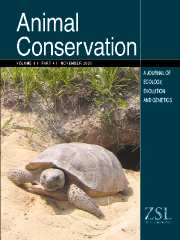Crossref Citations
This article has been cited by the following publications. This list is generated based on data provided by
Crossref.
HUANG, CHUAN‐CHIN
HSU, YU‐CHENG
LEE, LING‐LING
and
LI, SHOU‐HSIEN
2005.
Isolation and characterization of tetramicrosatellite DNA markers in the Eurasian otter (Lutra lutra).
Molecular Ecology Notes,
Vol. 5,
Issue. 2,
p.
314.
HÁJKOVÁ, P.
ZEMANOVÁ, B.
BRYJA, J.
HÁJEK, B.
ROCHE, K.
TKADLEC, E.
and
ZIMA, J.
2006.
Factors affecting success of PCR amplification of microsatellite loci from otter faeces.
Molecular Ecology Notes,
Vol. 6,
Issue. 2,
p.
559.
Adams, Jennifer R.
and
Waits, Lisette P.
2006.
An efficient method for screening faecal DNA genotypes and detecting new individuals and hybrids in the red wolf (Canis rufus) experimental population area.
Conservation Genetics,
Vol. 8,
Issue. 1,
p.
123.
Basu, Niladri
Scheuhammer, Anton M.
Bursian, Steven J.
Elliott, John
Rouvinen-Watt, Kirsti
and
Chan, Hing Man
2007.
Mink as a sentinel species in environmental health.
Environmental Research,
Vol. 103,
Issue. 1,
p.
130.
Ball, Mark C.
Pither, Richard
Manseau, Micheline
Clark, Jeff
Petersen, Stephen D.
Kingston, Steve
Morrill, Natasha
and
Wilson, Paul
2007.
Characterization of target nuclear DNA from faeces reduces technical issues associated with the assumptions of low-quality and quantity template.
Conservation Genetics,
Vol. 8,
Issue. 3,
p.
577.
Arrendal, Johanna
Vilà, Carles
and
Björklund, Mats
2007.
Reliability of noninvasive genetic census of otters compared to field censuses.
Conservation Genetics,
Vol. 8,
Issue. 5,
p.
1097.
Soulsbury, Carl D.
Iossa, Graziella
Edwards, Keith J.
Baker, Philip J.
and
Harris, Stephen
2007.
Allelic dropout from a high-quality DNA source.
Conservation Genetics,
Vol. 8,
Issue. 3,
p.
733.
Janssens, Xavier
C. Fontaine, Michaël
R. Michaux, Johan
Libois, Roland
de Kermabon, Jean
Defourny, Pierre
and
V. Baret, Philippe
2007.
Genetic pattern of the recent recovery of European otters in southern France.
Ecography,
Vol. 0,
Issue. 0,
p.
071122081926005.
Mucci, Nadia
and
Randi, Ettore
2007.
Sex identification of Eurasian otter (Lutra lutra) non-invasive DNA samples using ZFX/ZFY sequences.
Conservation Genetics,
Vol. 8,
Issue. 6,
p.
1479.
Centrón, Daniela
Ramirez, Benjamín
Fasola, Laura
Macdonald, David W.
Chehébar, Claudio
Schiavini, Adrián
and
Cassini, Marcelo H.
2008.
Diversity of mtDNA in Southern River Otter (Lontra provocax) from Argentinean Patagonia.
Journal of Heredity,
Vol. 99,
Issue. 2,
p.
198.
Lanszki, J.
Hidas, A.
Szentes, K.
Révay, T.
Lehoczky, I.
and
Weiss, S.
2008.
Relative spraint density and genetic structure of otter (Lutra lutra) along the Drava River in Hungary.
Mammalian Biology,
Vol. 73,
Issue. 1,
p.
40.
Janssens, Xavier
Fontaine, Michaël C.
Michaux, Johan R.
Libois, Roland
De Kermabon, Jean
Defourny, Pierre
and
Baret, Philippe V.
2008.
Genetic pattern of the recent recovery of European otters in southern France.
Ecography,
Vol. 31,
Issue. 2,
p.
176.
Elliott, John E.
Guertin, Daniel A.
and
Balke, Jennifer M.E.
2008.
Chlorinated hydrocarbon contaminants in feces of river otters from the southern Pacific coast of Canada, 1998–2004.
Science of The Total Environment,
Vol. 397,
Issue. 1-3,
p.
58.
Ferrando, Aïnhoa
Lecis, Roberta
Domingo-Roura, Xavier
and
Ponsà, Montserrat
2008.
Genetic diversity and individual identification of reintroduced otters (Lutra lutra) in north-eastern Spain by DNA genotyping of spraints.
Conservation Genetics,
Vol. 9,
Issue. 1,
p.
129.
SOTO‐CALDERÓN, IVÁN D.
NTIE, STEPHAN
MICKALA, PATRICK
MAISELS, FIONA
WICKINGS, ELIZABETH J.
and
ANTHONY, NICOLA M.
2009.
Effects of storage type and time on DNA amplification success in tropical ungulate faeces.
Molecular Ecology Resources,
Vol. 9,
Issue. 2,
p.
471.
Soulsbury, Carl D.
Iossa, Graziella
and
Edwards, Keith J.
2009.
The influence of evolutionary distance between cross-species microsatellites and primer base-pair composition on allelic dropout rates.
Conservation Genetics,
Vol. 10,
Issue. 3,
p.
797.
Hájková, Petra
Zemanová, Barbora
Roche, Kevin
and
Hájek, Bedřich
2009.
An evaluation of field and noninvasive genetic methods for estimating Eurasian otter population size.
Conservation Genetics,
Vol. 10,
Issue. 6,
p.
1667.
Koelewijn, H. P.
Pérez-Haro, M.
Jansman, H. A. H.
Boerwinkel, M. C.
Bovenschen, J.
Lammertsma, D. R.
Niewold, F. J. J.
and
Kuiters, A. T.
2010.
The reintroduction of the Eurasian otter (Lutra lutra) into the Netherlands: hidden life revealed by noninvasive genetic monitoring.
Conservation Genetics,
Vol. 11,
Issue. 2,
p.
601.
Mullins, Jacinta
Statham, Mark J.
Roche, Tom
Turner, Peter D.
and
O’Reilly, Catherine
2010.
Remotely plucked hair genotyping: a reliable and non-invasive method for censusing pine marten (Martes martes, L. 1758) populations.
European Journal of Wildlife Research,
Vol. 56,
Issue. 3,
p.
443.
Lanszki, J.
Hidas, A.
Szentes, K.
Révay, T.
Lehoczky, I.
Jeney, Zs.
and
Weiss, S.
2010.
Genetic structure of otter (Lutra lutra) populations from two fishpond systems in Hungary.
Mammalian Biology,
Vol. 75,
Issue. 5,
p.
447.


